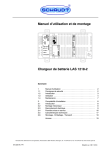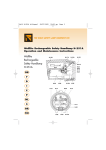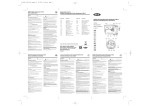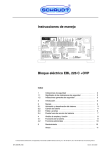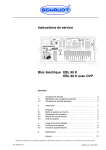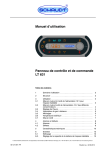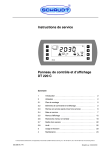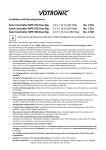Download Instruction Manual and Installation Instructions LAS
Transcript
Instruction Manual and Installation Instructions LAS 1218-2 Battery Charger Table of contents 1 1.1 1.2 1.3 1.4 Instruction manual . . . . . . . . . . . . . . . . . . . . . . . . . . . . . . . . . . . . . . Safety information . . . . . . . . . . . . . . . . . . . . . . . . . . . . . . . . . . . . . . Introduction . . . . . . . . . . . . . . . . . . . . . . . . . . . . . . . . . . . . . . . . . . . . Operation . . . . . . . . . . . . . . . . . . . . . . . . . . . . . . . . . . . . . . . . . . . . . . Maintenance . . . . . . . . . . . . . . . . . . . . . . . . . . . . . . . . . . . . . . . . . . . 2 2 3 4 7 2 2.1 2.2 2.3 2.4 2.5 2.6 Installation instructions . . . . . . . . . . . . . . . . . . . . . . . . . . . . . . . . . . 8 Introduction . . . . . . . . . . . . . . . . . . . . . . . . . . . . . . . . . . . . . . . . . . . . 8 Mechanical installation . . . . . . . . . . . . . . . . . . . . . . . . . . . . . . . . . . . 8 Electrical connection . . . . . . . . . . . . . . . . . . . . . . . . . . . . . . . . . . . . 9 Initial use . . . . . . . . . . . . . . . . . . . . . . . . . . . . . . . . . . . . . . . . . . . . . . 16 Technical details . . . . . . . . . . . . . . . . . . . . . . . . . . . . . . . . . . . . . . . . 17 Storage - Packaging - Transportation . . . . . . . . . . . . . . . . . . . . . . 18 Appendix . . . . . . . . . . . . . . . . . . . . . . . . . . . . . . . . . . . . . . . . . . . . . . 19 E Schaudt GmbH, Elektrotechnik und Apparatebau, Planckstraße 8, 88677 Markdorf, Germany, Tel. +49 7544 9577-0, Fax +49 7544 9577-29, www.schaudt--gmbh.de 810.523 BA / EN Date: 06.11.2014 Instruction Manual and Installation Instructions LAS 1218-2 1 Instruction Manual 1.1 Safety Information 1.1.1 Meaning of safety symbols DANGER! Failure to heed this warning may result in death or serious injury. Y WARNING! Failure to heed this warning may result in personal injuries. Y ATTENTION! Failure to heed this warning may result in damage to the device or connected consumers. Y 1.1.2 General safety information The device is state-of-the-art and complies with approved safety regulations. Nonetheless, personal injuries or damage to the device may occur if the safety instructions contained herein are not followed. Ensure that the device is in perfect working order before use. Any technical faults which may impact personal safety or the safety of the device must be rectified immediately by qualified personnel. DANGER! 230V mains voltage carrying parts. Danger of death due to electric shock or fire: Y F F F F F Connect devices rated at 230V to the 230V supply in line with national installation regulations. Never modify the device. Only carry out electrical work once the 230V supply has been disconnected. Never try to start the device using a defective mains cable or with a faulty connection. F Never carry out maintenance work on live devices. F Ensure proper electrical connections are made. F Ensure correct electrical fuses are used. F 2 The electrical system of the motorhome or caravan must comply with current DIN, VDE and ISO regulations. The mains connection line may only be replaced by an authorised customer service department or by qualified persons. Date: 06.11.2014 810.523 BA / EN Instruction Manual and Installation Instructions LAS 1218-2 WARNING! Hot components! Burns: Y F F F F F F 1.2 Only change blown fuses when the device is completely de-energised. Only replace blown fuses once the cause of the fault has been identified and rectified. Never bypass or repair fuses. Only use original fuses rated as specified on the device or in these instructions. The rear of the device may become hot during operation. Do not touch. Never store heat sensitive objects close to the device (e.g. temperature sensitive clothes if the device has been installed in a wardrobe). Introduction 1 2 3 4 5 Fig. 1 810.523 BA / EN LAS 1218-2 battery charger 1 2 3 4 5 Living area and start battery connectors Battery selector switch Indicator lamps for charging cycle Installation feet Mains cable with earthing type plug or WAGO®-connector (optional) Y This device is not intended to be used by persons (including children) with limited physical, sensory or mental aptitude or lack of experience and/or knowledge unless they are supervised by a person responsible for their safety or have received instruction from this person as to how the device is used. Y Children are to be supervised so as to ensure they do not play with the device. Y This device is intended for installation into a vehicle. Date: 06.11.2014 3 Instruction Manual and Installation Instructions LAS 1218-2 The LAS 1218-2 battery charger is for charging suitable batteries during 230V operation or supplying 12V consumers without connected battery with power. The device is a primary controlled switch-mode power supply unit. This modern switching technology achieves high charging performance at a compact size and low weight. The battery charger can be used: F F F 1.3 1.3.1 as a battery charger for charging the living area battery and for recharging a connected starter battery as an additional charger for charging the living area batteries having a higher capacity which match every Schaudt electroblock with a type LAS charger module as a power supply unit (up to 18 A) for the 12V consumers connected. No battery is required here. Operation Controls and indicator lamps The device has no controls which need to be used on a day-to-day basis. The battery selector switch need only be set correctly on initial use and for a change of battery. Battery selector switch DANGER! Risk of explosion! Y F Y ATTENTION! F An incorrectly set battery selector switch damages the living area battery. F Changing the battery An incorrect battery selector switch setting poses a risk of explosion due to the formation of electrolytic gases. Disconnect the battery charger from the mains before adjusting the battery selector switch. ³ Batteries may only be replaced by qualified personnel. ³ Follow the battery manufacturer’s instructions. ³ Charging unsuitable types of battery may damage them beyond repair. It is possible to swap lead acid batteries for lead gel batteries. Given the lack of ventilation options within the vehicle, changing from lead gel to lead acid batteries is not possible without additional overhead. Ask your dealer for advice. The switching option provided by the battery selector switch ensures optimum charging of the two battery types, lead gel and lead acid. The switch must be set to the correct battery type -- lead acid or lead gel. 4 Date: 06.11.2014 810.523 BA / EN Instruction Manual and Installation Instructions LAS 1218-2 Use a thin object (e.-g.- a ballpoint pen cartridge) to move the battery selector switch. Y Suitability must be checked on a case-by-case using specifications from the battery supplier and the charging parameters of Schaudt equipment. The charging parameters are specified in the operating and installation instructions. ³ Setting lead gel battery: Set the battery selector switch to ”Lead-gel”. ³ Setting lead acid battery: Set the battery selector switch to ”Lead-acid”. ³ If the battery charger is used to supply 12V consumers without connected battery with power, the battery selector switch must be set to ”Leadacid”. The indicator lamps on the front of the battery charger show the current charging phase. Main charge Full charge Trickle charge This indicator lamp lights up yellow in the ”Hauptladen” (Main charge) phase. This indicator lamp lights up yellow in the ”Vollladen” (Full charge) phase. This indicator lamp lights up green in the ”Erhaltungsladen” (Trickle charge) phase. Y 1.3.2 Flat vehicle fuses If the batteries are totally discharged, indicator lamp ”Erhaltungsladen” (Trickle charge) or ”Volladen” (Full charge) may light up for a while before the main charging phase begins. System faults A fault in the power supply system is usually caused by a blown fuse. Please contact our customer service department if you are unable to rectify the fault using the following table. If this is not possible, e.g. if you are abroad, you can have the battery charger repaired at a specialist workshop. Please note that the warranty becomes void if incorrect repair work is carried out. Schaudt GmbH cannot accept liability for any damages resulting from such repairs. 810.523 BA / EN Date: 06.11.2014 5 Instruction Manual and Installation Instructions LAS 1218-2 Fault Possible cause Remedy Living area battery is not charged during 230V operation (battery voltage continuously less than 13.3V) No mains voltage Switch on the circuit breaker in the vehicle Have the mains voltage checked Battery charger is defective Contact the customer service department Battery charger fuse or wiring is defective Check the fuse and wiring Living area battery is overcharged during 230V operation (battery voltage continuously greater than 14.5V) Battery charger is defective Contact the customer service department Starter battery is not charged during 230V operation (battery voltage continuously less than 13.0V) No mains voltage Switch on the circuit breaker in the vehicle 12V power supply in the li i g area does living d nott workk (when the battery charger is being used as a power supply device) Have the mains voltage checked Battery charger is defective Contact the customer service department Defective fuse or wiring Check the fuse and wiring Battery charger is defective Contact the customer service department No mains voltage Switch on the circuit breaker in the vehicle Have the mains voltage checked The ”Volladen” (Full charge) indicator lamp does not light up despite several hours of ”Main charge” (duration dependent on battery type) Defective battery Contact the customer service department The ”Erhaltungsladen” (Trickle charge) indicator lamp does not light up despite several hours of full charge Defective battery Contact the customer service department If the battery is not defective: Battery charger defective Contact the customer service department Y 6 The charging current is reduced automatically if the device becomes too hot due to excessive ambient temperature or lack of ventilation. Always prevent the device from overheating nevertheless. Date: 06.11.2014 810.523 BA / EN Instruction Manual and Installation Instructions LAS 1218-2 1.4 Maintenance The battery charger is maintenance-free. Cleaning 810.523 BA / EN Clean the battery charger with a soft, slightly damp cloth and mild detergent. Never use spirit, thinners or similar substances. Do not allow liquids to enter the device. Date: 06.11.2014 7 Instruction Manual and Installation Instructions LAS 1218-2 2 2.1 Installation instructions Introduction These installation instructions are aimed at trained personnel. They contain important information on the connection and safe operation of the device. The safety information provided must be observed. Always follow the relevant instruction manual in addition to the installation instructions. The following applications are described for the electrical connection (with the appropriate deliverables): F Auxiliary charger on electroblock (section 1.1.1.1) F Direct connection to living area and starter battery (section 1.1.1.2) F 2.2 2.2.1 Connection to additional battery (e.g. when using in conjunction with an inverter) (section 1.1.1.3) Mechanical installation LAS 1218-2 battery charger Y This device is intended for installation into a vehicle. The device was designed for floor installation. Environment Minimum clearance ³ Install in a dry, sufficiently ventilated location. No condensation is allowed to form on the device. To prevent a build-up of heat, ventilation holes facing the living area must be provided in the upper and lower areas of the place of installation. Its cross-section is based on the size and average temperature of the place of installation. ³ Keep a minimum clearance to the surrounding fixtures and fittings: F F Fitting 8 Maintain a gap of at least 5cm on all sides (except mounted side). Whilst in operation, the ambient temperature must not exceed +40 °C, measured 2.5 cm away from the sides of the device. ³ Screw the battery charger onto a firm, flat base with four screws (5mm diameter). Date: 06.11.2014 810.523 BA / EN Instruction Manual and Installation Instructions LAS 1218-2 247,5 118,1 134,2 147,2 163,5 80 90 Flat pins 6.3 x 0.8 in the insulation housing 4 x attachmentholes, ø4.5 Fig. 1 2.2.2 Dimension diagram of LAS 1218-2 battery charger (dimensions in mm) Fuse holder For applications that require one or two additional fuses (see sections 1.1.1.2 and 1.1.1.3 for example), fuse holders from the connector set must be installed. ³ Determine the place of installation of the fuse holder(s). The place of installation must be in the direct vicinity of the corresponding battery. ³ Drill a hole 8mm in diameter for every fuse holder. ³ Lock the fuse holder into place in the drillhole. 2.3 Connection sequence Electrical connection The battery charger connection is established in the following order: 1. All connections on the front panel of the battery charger 2. Battery lines to the battery terminals 3. 230V mains connection Disconnecting 2.3.1 Disconnect in the reverse order. Connections on the front panel ATTENTION! Short circuits! Damage to the battery charger or fire damage to cable: Y F 810.523 BA / EN To protect the supply lines in the event of a short circuit, connect the fuses directly to the positive terminal of battery. Date: 06.11.2014 9 Instruction Manual and Installation Instructions LAS 1218-2 Select cable cross-sections in line with EN 1648-1/-2. The maximum current load must not exceed 90% of the individual fuse rating. Recommended cable cross-sections: Fusing 1.1.1.1 Auxiliary charger Deliverables Line length* (sum of supply and return lines) Cable cross-section Up to 4 m 2,5 mm2 Up to 8 m (only for living area battery) 4,0 mm2 Up to 12 m (only for living area battery) 6,0 mm2 ³ Fuse the supply lines as follows: F with 1.5 mm2 cable cross-section 10 A F with 2.5 mm2 cable cross-section (or greater) 20 A Connection as for auxiliary charger to the electroblock The LAS 1218-2 battery charger can also be used as an auxiliary charger for a Schaudt electroblock. Suitable for use here are all Schaudt electroblocks that include the LAS charger module and have the 2-pin MN connector (e.g. EBL 99) or Minifit connector (e.g. EBL 220) for an auxiliary charger. See the instruction manual for the electroblock, ”Suitable accessories”. The following parts are supplied for this application: F Item number 999.085 with MNL connector F Item number 999.161 with Minifit connector 2 1 3 Fig. 2 Connector set deliverables Pos. 1 Qty 1 2 3 1* 1* Name LAS 1218-2 battery charger, earthing type plug connection example Connector cable, 1.7m with Minifit connector Connector cable, 1.7m with MNL connector * Pos. 2 and 3 as an alternative depending on electroblock to be connected 10 Date: 06.11.2014 810.523 BA / EN Instruction Manual and Installation Instructions LAS 1218-2 The connector cable (Pos. 2 or 3) is required to connect the LAS 1218-2 battery charger to the electroblock. Fusing An additional fuse is not required as there is already one integrated in the electroblock. You only have to check if the fuse is fitted and if it complies with the fuse rating on the label. The battery charger is connected to the electroblock with a 2-pin charger cable. Other lengths are available on request. A connection to the starter battery is not required, because the electroblock already has the start battery recharge module. X 1 3 2 4 5 X Fig. 3 1 2 3 4 5 Connection Diagram of LAS 1218-2 Battery Charger -- on Electroblock Flat push-on contacts, 6.3 x 0.8, red cable Flat push-on contacts, 6.3 x 0.8, brown cable not assigned + Living area battery (red) Negative battery (brown) ³ 2-pin charger cable: LAS 1218-2 to electroblock connection F F F 810.523 BA / EN + terminal of LAS 1218-2 living area battery: Flat push-on contact, 6.3 x 0.8; (Fig.3; Pos. 1) -- terminal of LAS 1218-2: Flat push-on contact, 6.3 x 0.8; (Fig.3; Pos. 2) MNL connector (view X, Fig. 3; Pos. 4/5) or Minifit connector on electroblock, base ”auxiliary charger” ; see also instruction manual for electroblock Date: 06.11.2014 11 Instruction Manual and Installation Instructions LAS 1218-2 1.1.1.2 Direct connection to living area and starter battery For this type of connection, there is a direct connection between the LAS 1218-2 battery charger and the two motorhome batteries (or also only one battery, e.g. for a caravan). Deliverables The following parts are supplied under item number 999.086 for this application: 1 6 7 2 Fig. 4 Pos. 1 2 3 4 5 6 7 5 3 4 Connector set deliverables Qty 1 7 3 3 2 1 1 Name LAS 1218-2 battery charger Flat push-on contacts, 6.3 x 0.8 (blue) Ring terminal, 1 ... 2.5 mm2 M6 Ring terminal, 1 ... 2.5 mm2 M8 Fuse holder for flat vehicle fuse Flat vehicle fuse, 20A Flat vehicle fuse, 10 A The connector set (Pos. 2 to 6) is required to connect the LAS 1218-2 battery charger to up to two batteries. Y 12 The length of the line to the starter battery may not exceed 4 m (supply and return lines together) for a cable cross-section of 2.5mm2 (see also table on page 10). Date: 06.11.2014 810.523 BA / EN Instruction Manual and Installation Instructions LAS 1218-2 2 1 3 Fig. 5 4 Connection Diagram, LAS 1218-2 Battery Charger to Living Area and Starter Battery Fuse F1 Fuse F2 Living area battery Starter battery 1 2 3 4 ³ + terminal of LAS 1218-2 living area battery (flat push-on contact 6.3 x 0.8) to F1 (flat push-on contact 6.3 x 0.8) ³ F1 (flat push-on contact 6.3 x 0.8) to + terminal of living area battery (ring terminal, M6 or M8) ³ + terminal of LAS 1218-2 starter battery (flat push-on contact 6.3 x 0.8) to F2 (flat push-on contact 6.3 x 0.8) ³ F1 (flat push-on contact 6.3 x 0.8) to + terminal of starter battery (ring terminal, M6 or M8) ³ Connection, LAS 1218-2 to living area or starter battery F -- terminal of LAS 1218-2 (flat push-on contact 6.3 x 0.8) F -- terminal of battery (ring terminal, M6 or M8) ³ Label the two fuses with stickers ”F1 -- living area battery” and ”F2 -- starter battery”. Y 810.523 BA / EN The negative terminal (-- Pol) of the living area battery must be connected externally to the negative terminal (-- Pol) of the starter battery. Date: 06.11.2014 13 Instruction Manual and Installation Instructions LAS 1218-2 1.1.1.3 Connection to additional battery (such as when using in conjunction with inverter) With this type of connection, the LAS 1218-2 battery charger is used for loading an additional battery. Deliverables The following parts are supplied under item number 999.086 for this application: 1 6 7 2 Fig. 6 Pos. 1 2 3 4 5 6 7 5 3 4 Connector set deliverables Qty 1 7 3* 3* 2* 1 1* Name LAS 1218-2 battery charger Flat push-on contacts, 6.3 x 0.8 (blue) Ring terminal, 1 ... 2.5 mm2 M6 Ring terminal, 1 ... 2.5 mm2 M8 Fuse holder for flat vehicle fuse Flat vehicle fuse, 20A Flat vehicle fuse, 10 A * Pos. 3 and 4 each only required 2 x, Pos. 5 only 1 x, Pos. 7 not used. The connector set (Pos. 2 to 6) is required to connect the LAS 1218-2 battery charger to the additional battery. The application shown in Fig. 7 is based on articles ”Connector sets for integration of an inverter” (article nos 798.023 and 999.208) available from Schaudt. In principle, such a connection is always suitable when an addition battery is charged. Y The length of the line to the additional battery may not exceed 4 m (supply and return lines together) for a cable cross-section of 2.5mm2 (see also table on page 9). ³ + terminal of LAS 1218-2 (flat push-on contact 6.3 x 0.8) to F4 (flat pushon contact 6.3 x 0.8) 14 Date: 06.11.2014 810.523 BA / EN Instruction Manual and Installation Instructions LAS 1218-2 ³ F4 (flat push-on contact 6.3 x 0.8) to + battery terminal (ring terminal, M6 or M8) ³ LAS 1218-2 to additional battery connection F -- terminal of LAS 1218-2 (flat push-on contact 6.3 x 0.8) F -- terminal of battery (ring terminal, M6 or M8) ³ Label the additional fuse with sticker ”F4 -- additional battery”. 230 V D+ GB Fa LRS 12 V DT ... / LT ... Shunt -- + G2 G1 -- EBL ... Fb + F1 K1 LAS 1218-2 F2 12 V F3 -- Fig. 7 Pos. DC/AC DT.../LT... + G3 230 V 230 V + -- DC/AC F4 Example circuit diagram, inverter installation (grey background: LAS 1218-2 battery charger with connector set) Name Inverter DT ... or LT ... control and display panel in the vehicle Pos. F4 G Name Fuse, additional battery charge current Vehicle alternator (higher rating) EBL ... Fa Electroblock Fuse, EBL ... charge current for starter battery G1 G2 Starter battery Living area battery Fb Fuse, EBL ... charge current for living area battery G3 Additional battery F1 Fuse, starter battery -- cut-off relay K1 Cut-off relay, starter battery -- additional battery F2 F3 Fuse, cut-off relay -- additional battery Fuse, inverter supply 810.523 BA / EN LAS 1218-2 Battery charger LAS Charger module of electroblock Date: 06.11.2014 15 Instruction Manual and Installation Instructions LAS 1218-2 2.3.2 Mains connection DANGER! 230V mains voltage carrying parts. Danger of death due to electric shock or fire: Y F Mains connection Only carry out electrical work once the 230V supply has been disconnected. ³ The mains must be connected as follows: F F to a insulated distribution unit with protective contact to a socket with protective contact (isolated ground or suitable plug connector from WAGO® , depending on LAS 1218-2 variant). The power cord must be of type H05VV-F 3x1.5. ³ The mains cable must have a strain relief where required. 2.4 2.4.1 Before starting up 2.4.2 Initial use Checks prior to initial use ³ Ensure that the batteries are connected properly (only for initial use, operation without battery is possible in general). Setting battery type ³ Establish battery type. DANGER! Incorrect setting of the battery selector switch. Risk of explosion from build-up of electrolytic gas, defective battery, defective battery charger or as a result of too high a battery operating temperature (above 30 °C): Y F F Move the battery selector switch to the correct position. The battery charger is to be used solely for connecting to the 12V power supply with rechargeable 6-cell lead-gel or lead-acid batteries. Do not use any unsuitable battery types. ³ Store batteries in a place with adequate ventilation (or provide integrated ventilation). Follow the instructions provided by the battery manufacturer. lead-acid Fig. 8 16 lead-gel Battery selector switch lead-gel-/lead-acid battery. Date: 06.11.2014 810.523 BA / EN Instruction Manual and Installation Instructions LAS 1218-2 ³ Disconnect the battery charger from the mains before moving the battery selector switch. ³ Move the battery selector switch (see Fig. 8) into the correct position using a thin object, such as a ballpoint pen: F Lead gel battery: Move the battery selector switch to ”Lead-gel”. F Lead acid battery: Set the battery selector switch to ”Lead-acid”. ³ Re-check that the battery selector switch is set correctly for the type of battery used. Y 2.4.3 Suitability must be checked on a case-by-case using specifications from the battery supplier and the charging parameters of Schaudt equipment. The charging parameters are specified in the operating and installation instructions. Starting up the system ³ Ensure that the battery is connected correctly (or all if more than one is available). ³ 230V mains supply must be connected to vehicle. ³ Power on the electrical system of the vehicle (e.g. power on 12V main switch on the switch panel, see instruction manual for switch panel connected). ³ 230-V- mains cable of the LAS 1218-2 charger must be connected (the charger does not have its own mains switch). ³ Check whether the batteries are being charged (display on the battery charger). 2.5 2.5.1 Dimensions Weight Housing 2.5.2 Mains connection Current consumption Suitable batteries Standby current from living area battery Current-carrying capacity 810.523 BA / EN Technical details Mechanical details ca. 90 x 148 x 248 (H x W x D in mm), including attachment feet 1.0 kg Polyamide blue, similar to RAL 5010 Electrical details 230 V AC voltage +10%, 47 -- 63 Hz sinusoidal, protection class I 1.9 A 6-cell lead acid or lead gel batteries, 55 Ah and above approx. 0.3 mA Conditions for the measurement: F approx. 10 min after mains isolation without mains connection F with battery connected (battery voltage 12.6V) 12V outputs A maximum of 90% of the nominal current of the relevant fuse may be drawn. Date: 06.11.2014 17 Instruction Manual and Installation Instructions LAS 1218-2 Battery charging via mains connector Living area battery Charging curve IUoU Final charging voltage 14.3 V Charge current 18 A in the entire mains voltage range, electronically limited, minus the charge current into the vehicle battery Voltage for float charge 13.8 V with automatic switchover New charge cycle, Switchover to main charging with battery voltage below 13.8 V with approx. 5 seconds delay Solar charging V Main charge I Full charge Uo Float charge U 14,3 13,8 4 h with lead acid 16 h with lead gel Time Fig. 9 I Example of the charge voltage behaviour with the LAS 1218-2 battery charger Main charge with maximum 18 A charging current, electronically limited, up to final charging voltage. Start of charge also for totally discharged batteries. Uo Automatic changeover to full charge with constant 14.3 V. The duration of the full charge phase depends on the type of battery and is configured on the device: Lead-acid batteries, 4 hour, lead-gel batteries, 16 hours. U Automatic changeover to trickle charge with constant 13.8V. In the trickle charge phase, the voltage at the output of the charging module is constant. The battery is now fully, or virtually fully, charged. Start of a new charging cycle by switching over to main charge, if the battery voltage falls below 13.8 V for more than 5 seconds when loaded. Start of charge also for totally discharged batteries. Battery charging of the starter battery Operation as power supply unit 2.5.3 Operating temperature Storage temperature Humidity For mains operation, the starter battery is also charged (with maximum charge current of 3A). The final charge voltage is 14.1 V. Output current 18 A, connection of a battery not required Output voltage 14.3V/13.8V, suitable for 12V consumers, smoothed DC voltage Environmental parameters -20 °C to +45 °C -20 °C to +70 °C Operation in dry environment only CE CE mark 2.6 Storage - Packaging - Transportation Only transport and store the battery charger if the packing is suitable and ambient conditions are dry. E 18 No part of this manual may be reproduced, translated or copied without express written permission. Date: 06.11.2014 810.523 BA / EN Instruction Manual and Installation Instructions LAS 1218-2 Appendix A EC Declaration of Conformity Schaudt GmbH hereby confirms that the design of the LAS 1218-2 battery charger complies with the following relevant regulations: F F F EC-Low Voltage Directive: tions 73/23/EEC edition with modifica- Directive on Electromagnetic Compatibility 89/336/EEC with modification 92/31/EEC from 22.07.93 Norms and technical specifications applied, in particular: -- DIN EN 60335-1: 1994 + A11 + A1 + A12 + A13 + A14 -- DIN EN 60335-2-29: 1996 + A11 -- DIN EN 50081-1: 3.1993 -- DIN EN 50082-1: 3.1993 -- DIN EN 61000-3-2: 2000 The original EC Declaration of Conformity is available for reference at any time. Manufacturer Schaudt GmbH, Elektrotechnik & Apparatebau Address Planckstraße 8 88677 Markdorf Germany B Accessories Additional charger As a standalone device C Customer service address Suitable connector cable (MNL or Minifit) to Schaudt eletroblock. Connector set with fuse holders and connector material Customer service Schaudt GmbH, Elektrotechnik & Apparatebau Planckstraße 8 D-88677 Markdorf tel.: +49 7544 9577-16 email: [email protected] Office hours Send in the device Mon to Thurs Fri 08.00 -- 12.00, 13.00 -- 16.00 08.00 -- 12.00 Returning a defective device: ³ Fill in and enclose the fault report, see Appendix D. ³ Send it to the addressee (free of charge). 810.523 BA / EN Date: 06.11.2014 19 Instruction Manual and Installation Instructions LAS 1218-2 D Fault report In the event of damage, please return the defective device together with the completed fault report to the manufacturer. Device type: Item no.: Vehicle: _______________________ _______________________ Manufacturer: _______________________ Model: _______________________ Own installation? Yes - No Upgrade? Yes - No - Following fault has occurred (please tick): - Electrical consumers do not work -- which? (please specify below) - Switching on and off not possible - Persistent fault - Intermittent fault/loose contact Other remarks: 20 Date: 06.11.2014 810.523 BA / EN




















